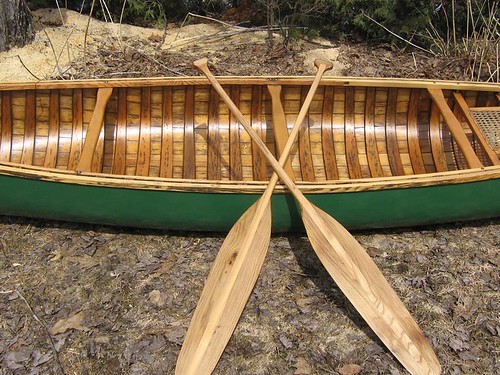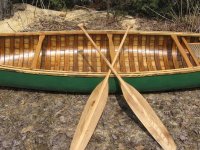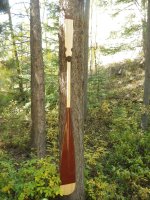-
Happy Birthday, Nostradamus (1503-1566)! 🔮🌃♐
You are using an out of date browser. It may not display this or other websites correctly.
You should upgrade or use an alternative browser.
You should upgrade or use an alternative browser.
Paddles
- Thread starter Jamie
- Start date
- Joined
- Mar 20, 2013
- Messages
- 3,356
- Reaction score
- 485
Nice looking paddle, not my favourite style of blade, but look like you did a great job!!
For years I paddled only shallow rocky rivers, with cheap big box store paddles. Tried one of these paddles when I moved to doing a bit of lake travel and the difference was night and day.... and they look nice too.Nice looking paddle, not my favourite style of blade, but look like you did a great job!!
So if not an ottertail for deep water, what's everyone's preference?
Well done, those are beautiful.
Very good looking paddles. Did you build them with hand tools or do you have a shop with bigger powers tools like plainers etc.?
I prefer beavertail paddles with my Chestnuts , I never owned an ottertail and really never gave them much of a tryout. I always was concerned with the depth they went under the canoe, so I just carry 2 beavertails.
, I never owned an ottertail and really never gave them much of a tryout. I always was concerned with the depth they went under the canoe, so I just carry 2 beavertails.
I prefer beavertail paddles with my Chestnuts
So if not an ottertail for deep water, what's everyone's preference?
Some of us are non-animal tail paddle users. I prefer something like a Sugar Island type blade. Perhaps we could call it a modified beaver tail, if the beaver tail was 8 inches wide and the blade was cut in half, but then it wouldn't really look like a beaver tail. So I guess I'll just say I like a shorter, wider blade that doesn't resemble any animal tails.
I like the look of your paddles, but it seems you have widened them out considerably from a regular otter tail What's the widest measurement?
I do have some power tools that help for making laminated shafts, a jointer, band saw and a thickness planner. I use a hand held electric planner to take off most of the excess, normal hand tools would work just fine, just more time consuming. Once the blade is roughly shaped I take out the hand planes and spoke shaves.Very good looking paddles. Did you build them with hand tools or do you have a shop with bigger powers tools like plainers etc.?
Some of us are non-animal tail paddle users. I prefer something like a Sugar Island type blade. Perhaps we could call it a modified beaver tail, if the beaver tail was 8 inches wide and the blade was cut in half, but then it wouldn't really look like a beaver tail. So I guess I'll just say I like a shorter, wider blade that doesn't resemble any animal tails.
I like the look of your paddles, but it seems you have widened them out considerably from a regular otter tail What's the widest measurement?
For shallow rivers I use paddles similar to Sugar island but don't find them as nice in deep water.
These paddles are only about 6" wide, plans for the paddles were taken out of a book with a bunch of templates, may have been Graham Warren's books on paddle making.
- Joined
- Mar 20, 2013
- Messages
- 3,356
- Reaction score
- 485
No Title
My favorite blade shape is one of the Tête de Boule first nation from Quebec. That blade shape gives more purchase when it get shallow, but still work great in deep water. I just like it better for tripping with loaded canoe, I even use it on river and it is really good, as long as there is water. I reinforced the tip so it sustain quite a bit of abuse!!
Other than the bandsaw to rough out the blank, I do use only hand tools for my paddles... For the deep/lake/traditional paddles anyway.
My favorite blade shape is one of the Tête de Boule first nation from Quebec. That blade shape gives more purchase when it get shallow, but still work great in deep water. I just like it better for tripping with loaded canoe, I even use it on river and it is really good, as long as there is water. I reinforced the tip so it sustain quite a bit of abuse!!
Other than the bandsaw to rough out the blank, I do use only hand tools for my paddles... For the deep/lake/traditional paddles anyway.
Attachments
Last edited:
- Joined
- Dec 12, 2014
- Messages
- 364
- Reaction score
- 2
I have a Turtle Works ottertail that I've used only a couple of times. It's good only for in-water recoveries, which I don't do much. For rivers I much prefer an 8"x20" or so paddle such as Bending Branches' Espresso ST, or a Grey Owl Freestyle. For lakes it's a Bell/Mitchell 10* bent with a smallish graphite blade and wood shaft.
Similar threads
- Replies
- 56
- Views
- 6K
- Replies
- 39
- Views
- 3K

 [/url
[/url
